Fes Medina – 9,000 Ways to Get Lost
In the last post from the Adventures Abroad Quintessesntial Tour of Morocco we arrived in the fabled city of Fes, Morocco’s second city and the home of the world’s largest medina. Covering 280 hectares or about 700 football fields, it is home to over 150,000 residents along with hundreds and hundreds of shops and restaurants. There are also many active enterprises that have been here for over 1,000 years making textiles, metal works, pottery and there’s even a massive tannery. It is home to the world’s oldest institute of higher learning which I described in the last post, as well as numerous mosques, madrasas, riads and even a mausoleum. Perhaps the most interesting fact is that there are an estimated 9,000 streets, alleyways and lanes, all in a completely maze-like jumble that leads even life long residents to occasionally get lost. The entire complex is a UNESCO World Heritage Site which describes the Fes medina thus:
The Medina of Fez constitutes an outstanding example of a medieval town created during the very first centuries of Islamisation of Morocco and presenting an original type of human settlement and traditional occupation of the land representative of Moroccan urban culture over a long historical period (from the 9th to the beginning of the 20th centuries). The ancient fragmented district of the medina with its high density of monuments of religious, civil and military character, are outstanding examples of this culture and the resulting interaction with the diverse stratas of the population that have influenced the wide variety of architectural forms and urban landscapes.
This promises to be one of the highlights of the entire Morocco tour, so please join us as we slip back in time to explore the Fes medina.
As I noted in the first post from Fes, the city first developed as two settlements on the opposite banks of the Oued Fes or Fes River that were consolidated into one grand medina in the 11th century. The typical components of a medina are firstly, an area that is surrounded by walls with numerous gates, a labyrinthian street system, many traditional souks (markets) and most importantly, not an historical site, but a living, breathing urban conglomeration where people go about their business as they have for hundreds and hundreds of years. The Fes medina is noteworthy not only for being the largest in the world, but also the largest exhaust free zone in any city in the world. Unlike the Marrakech medina where motorbikes are ubiquitous and obnoxious, they are not permitted inside the Fes medina, although a few do manage to sneak in. This makes the Fes medina a much more enjoyable place to explore than Marrakech.
We start our visit to the Fes medina in Fes Jdid or New Fes which only dates back about 800 years. Here is our group outside the main gate to the Royal Palace of Fes which is still an active royal residence.
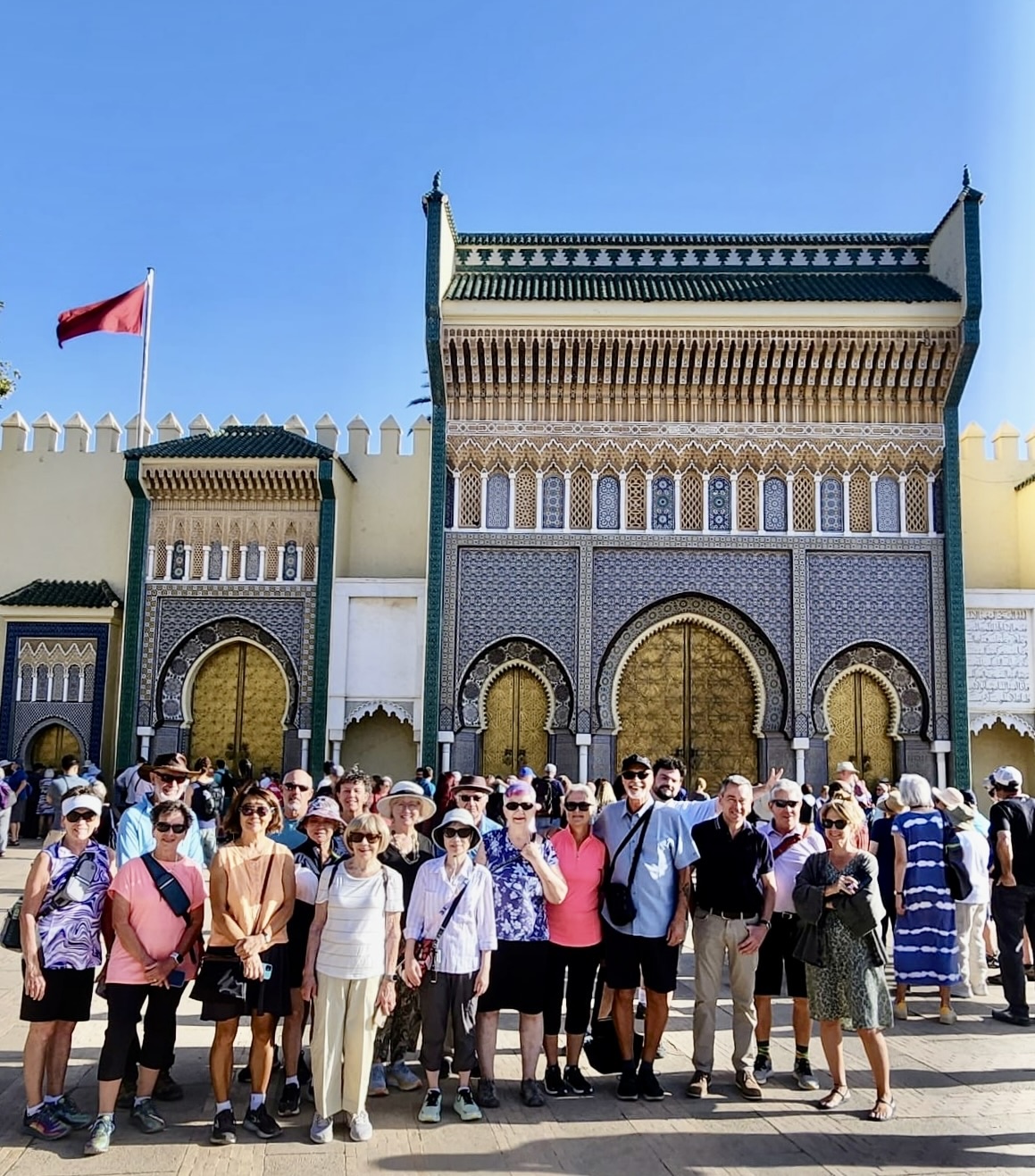
Here is what the palace main gate looks like without the myriad crowds that accumulate outside its walls; simply beautiful, almost mesmerizing patterns attract the eye.

New Fes is also where we find the remnants of the Jewish quarter or mellah as it is properly called. In contrast to the dars and riads of the Muslim population of the Fes medina, the Jewish homes have outside balconies and a completely different look that is frankly, quite refreshing compared to the blank walls of most of the buildings in the medina.

Similar to what we learned in Meknes, the once flourishing Jewish population of over 20,000 in post war Fes, has now dwindled to about 150.
Okay, say goodbye to the sunshine as our guide leads us into what appears to be a rather dubious looking entrance to Fes el-Bali or Old Fes. Note the fountain, one of about 60 to be found within the Fes medina. BTW, although Fes supposedly has the Oued Fes flowing through it, I saw no signs whatsoever of a river either within or without the walls of the medina.
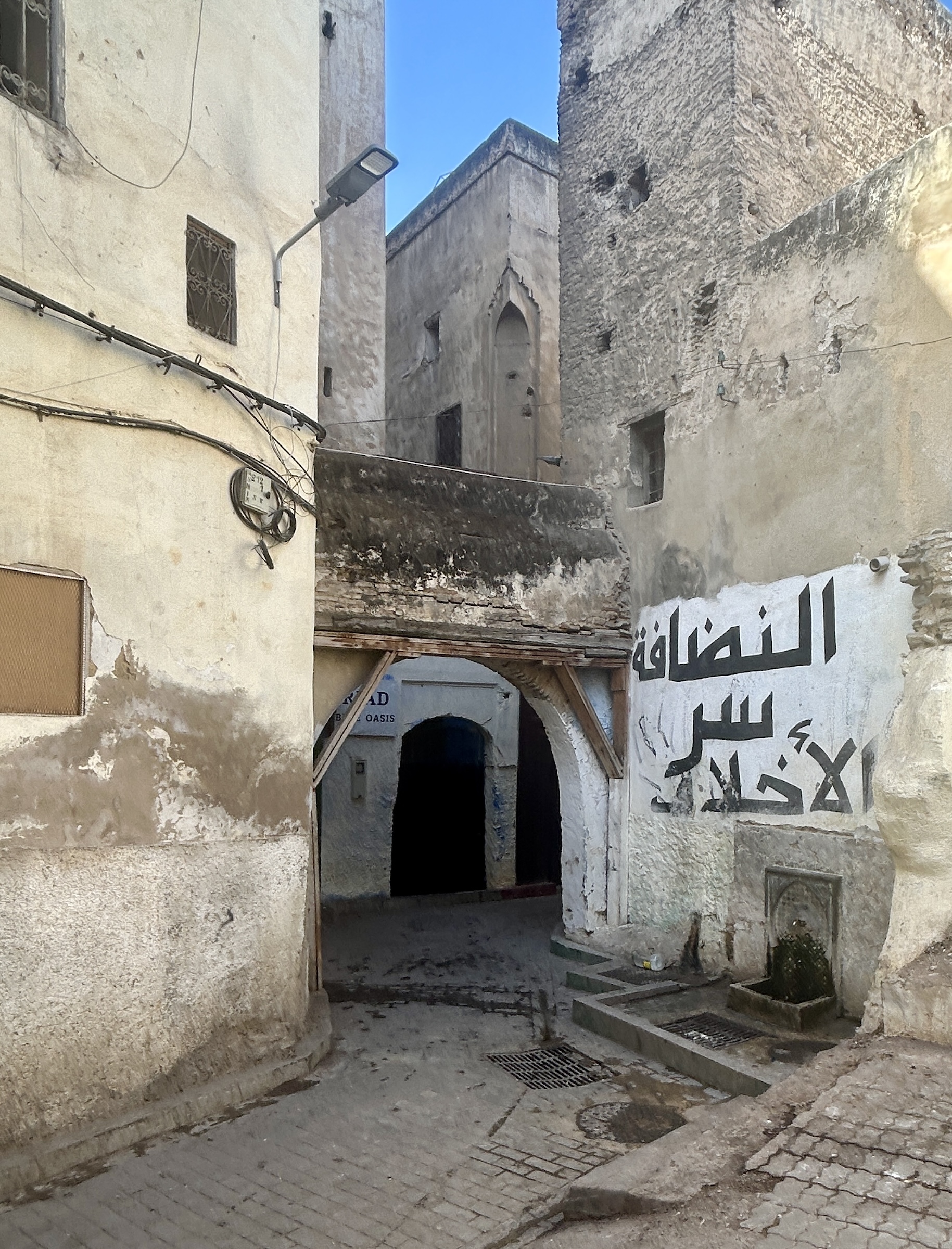
In my introductory post on Morocco I commented that it is imperative that one visit on a guided tour and not try to see the country on one’s own. No where is that more apparent than in visiting the Fes medina where only an idiot would try to navigate this place without a guide.
I also mentioned the importance of visiting in a small group. This is an example of how narrow the alleyways of the Fes medina are in places.
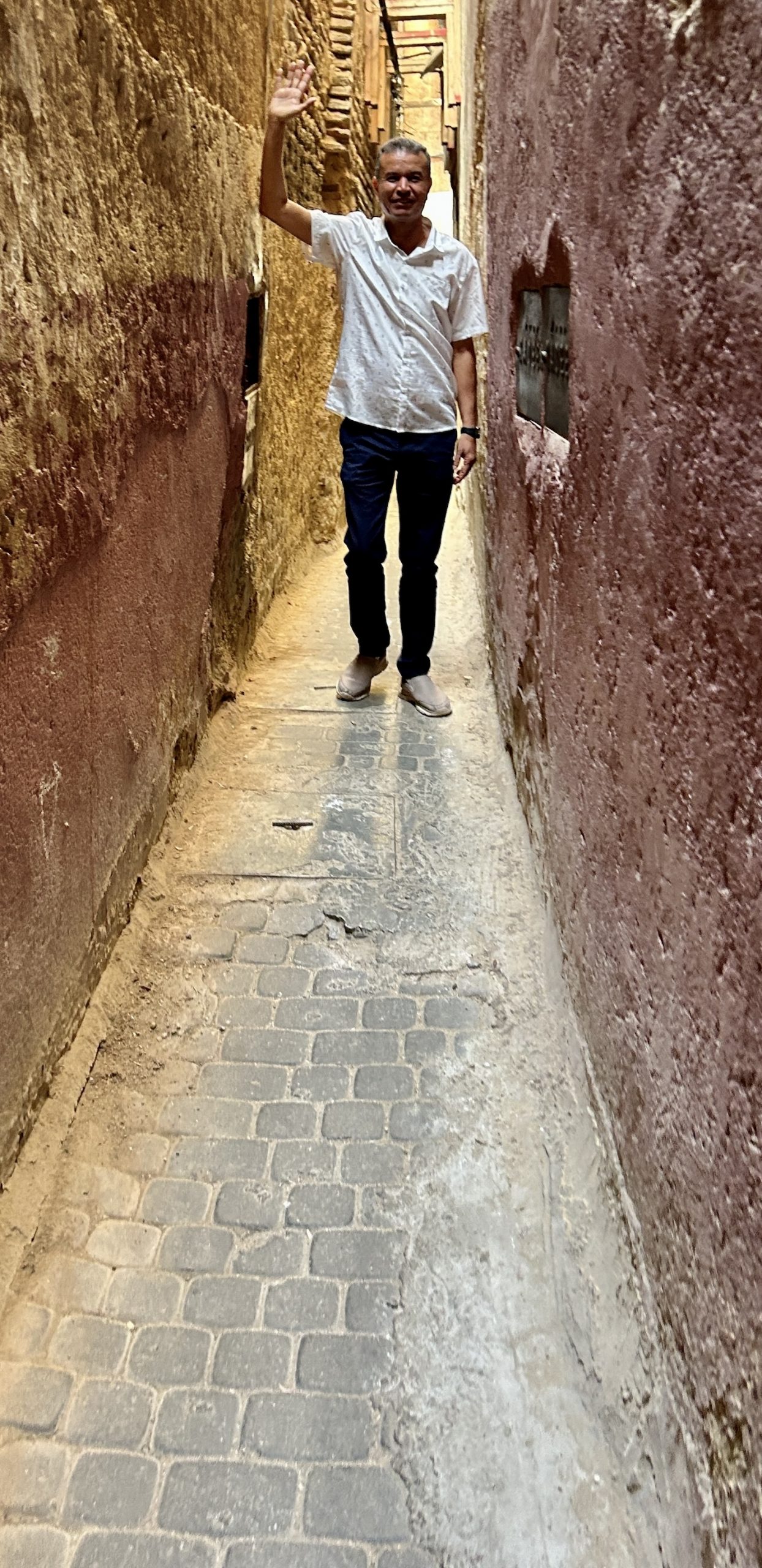
Now imagine a group of 60 or more mostly overweight tourists coming at you in a lane this narrow.
While tourists come to Fes medina to see the bright colours, revel in the aromas of cooking food and generally enjoy being in the midst of an entirely different world, the reality is that most of the people who actually live here have their homes off streets like this one.

One of the stipulations of our guides is that if you somehow get separated from the group, which is very easy to do, remain where you are. This is a much more typical scene in the Fes medina. Most of the people are not tourists and although it doesn’t seem possible, you are constantly asked to give way to carters hauling goods on carts that are almost as wide as the street.

You might be thinking, is this a safe place to be? The answer is yes. While in places you are in a crush of humanity, thieves and pick pockets are not really a thing in the Fes medina. Nor will you constantly be assailed by aggressive shop keepers like you would be in Egypt or Turkey. The reality is that this place is not a tourist trap and the locals going about their business pretty well ignore you. That is what, to my mind, set the Fes medina apart from many of the others Alison and I visited on this and other trips. I know ‘authentic’ is a tricky word to describe a place that is crawling with tourists, but in the case of the Fes medina I think it is accurate.
If you want to get a break from the milling crowds that jam the main thoroughfares there are any number of shops to step into.
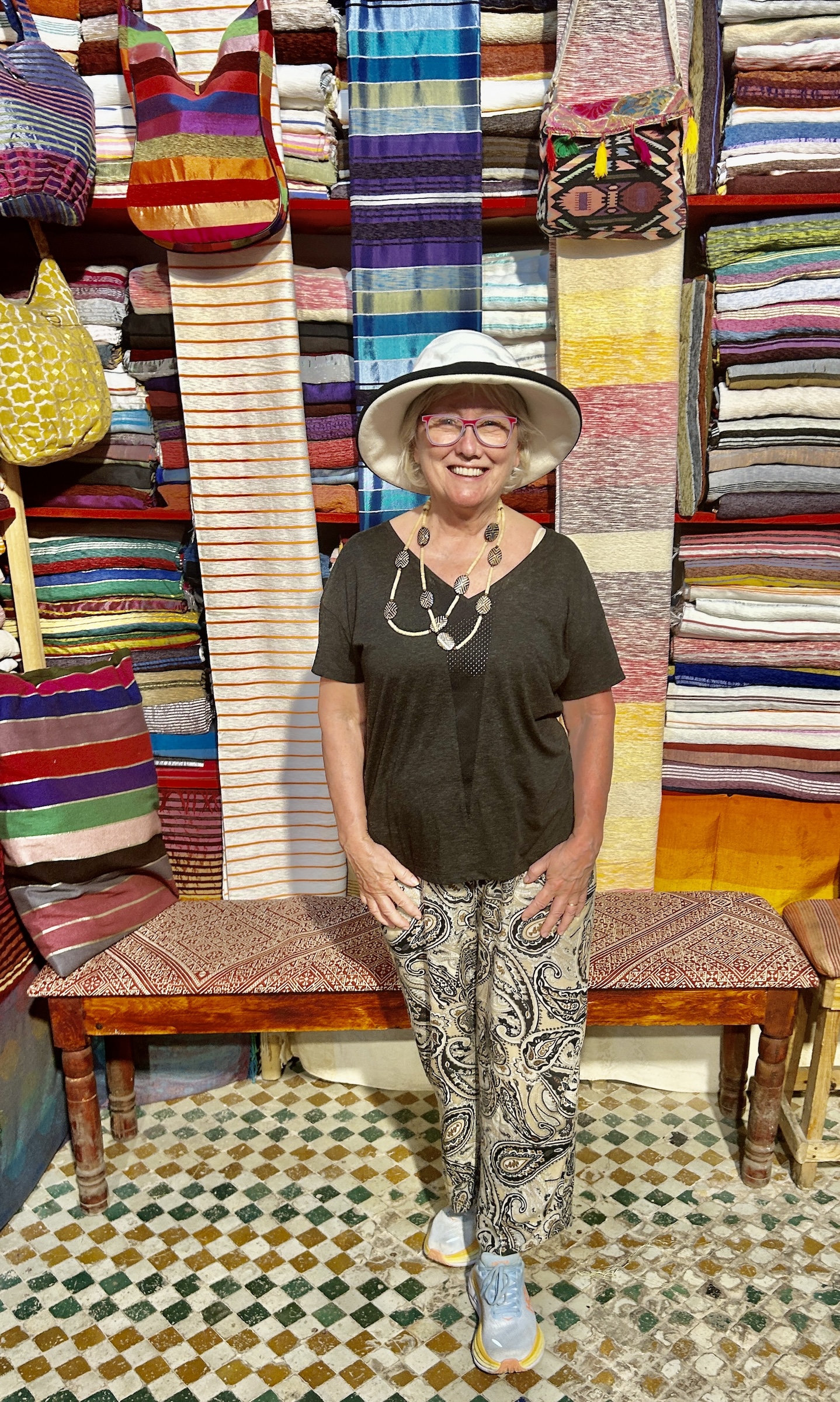
Or you can sample one of the delicious looking pastries on offer.
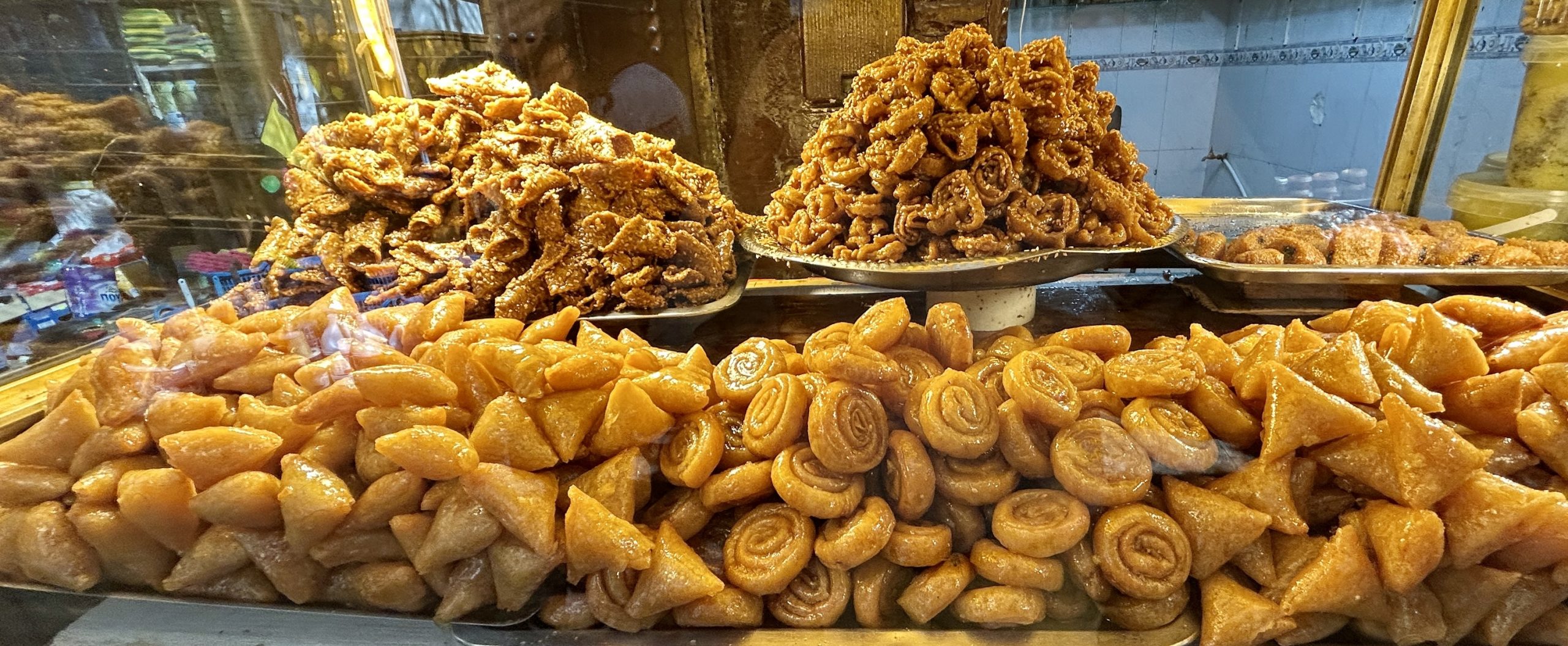
As I mentioned there are some important historical sites inside the Fes medina and we visited a few of them, including passing by the entrance to the Fes university. The most important of these is the mausoleum of Moulay Idris II, the man who founded Fes in the 8th century. It is a large religious complex with several gates, all beautifully crafted.

Only one is open and non-Muslims are allowed to peer in, but can go no farther which is a contrast to the mausoleum of the modern kings which we visited in Rabat.

This wax stained niche just outside the mausoleum is the site of a ritual that dates back 1,000 years. Women hoping to find a husband or wives hoping to get pregnant light a candle here and hope their wishes are granted.

However, what I will most remember about the Fes medina was watching people engaged in making traditional crafts using methods that have not changed in centuries.
These are pots of dye used for colouring yarn and cloth, that line an area of streets dedicated to the trade. How they don’t get kicked over by any of the thousands of people, animals, carts and bikes that pass within inches of them, is beyond me.
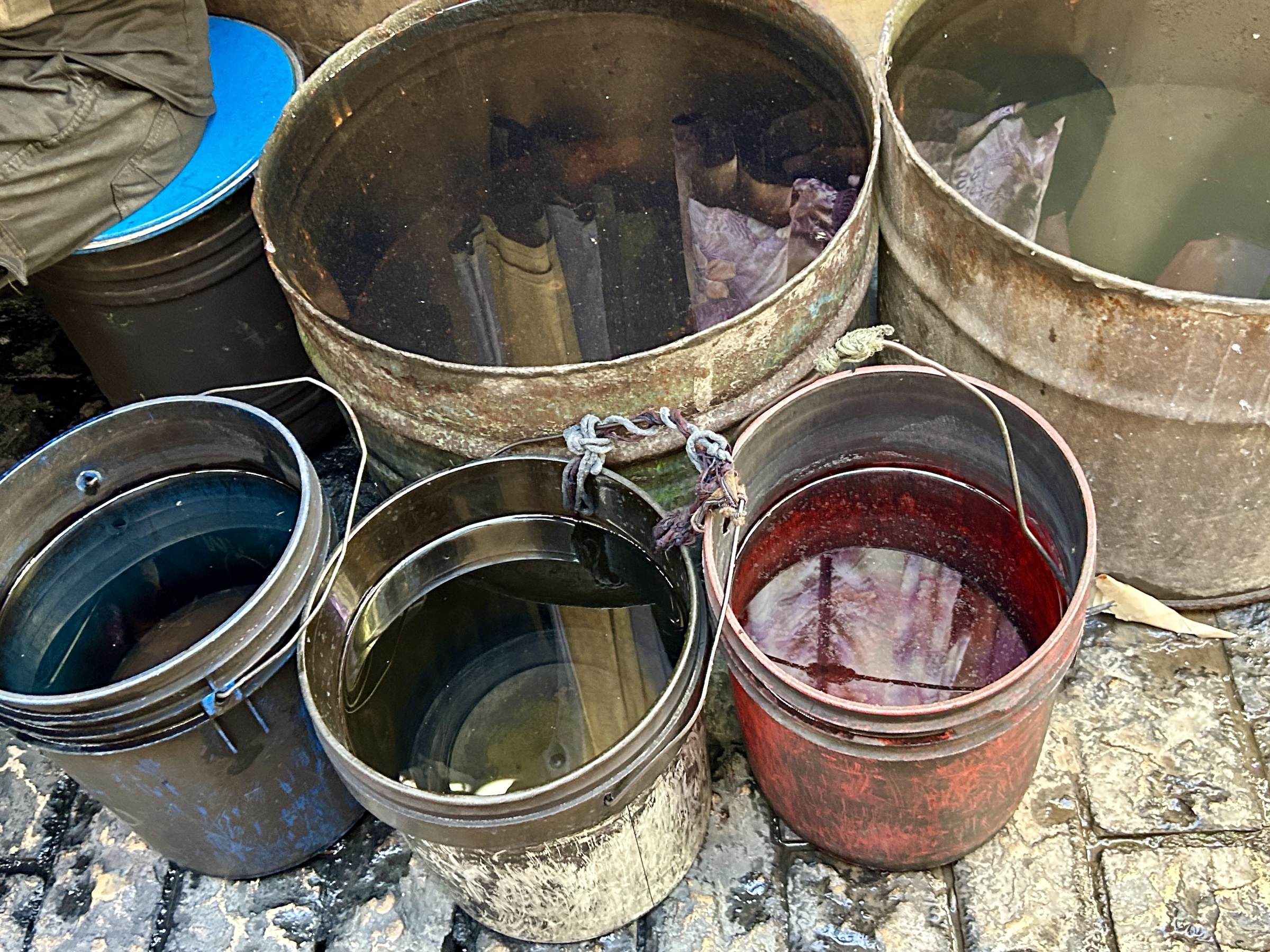
The finished products, hanging overhead, make for a very colourful photo.
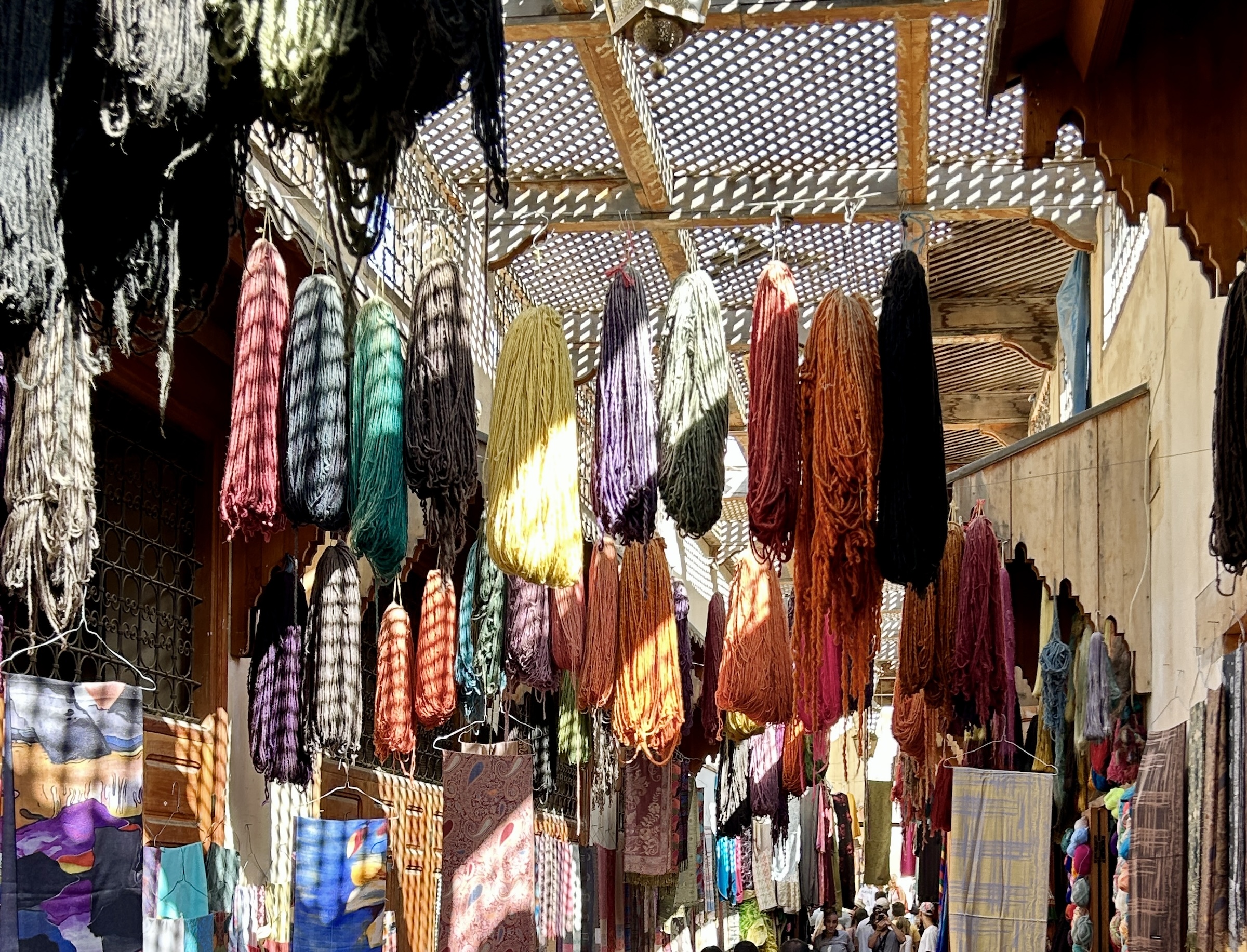
Not far from where the yarns are made, you come across men working looms and creating the beautiful cloths for sale in the nearby shops.

One of the delights of Moroccan cuisine are the pastillas which come both as a main course meat pie or as a dessert. This is what a really good looking dessert pastilla looks like filled nuts, spices and other savoury goodies and it tastes even better than it looks.
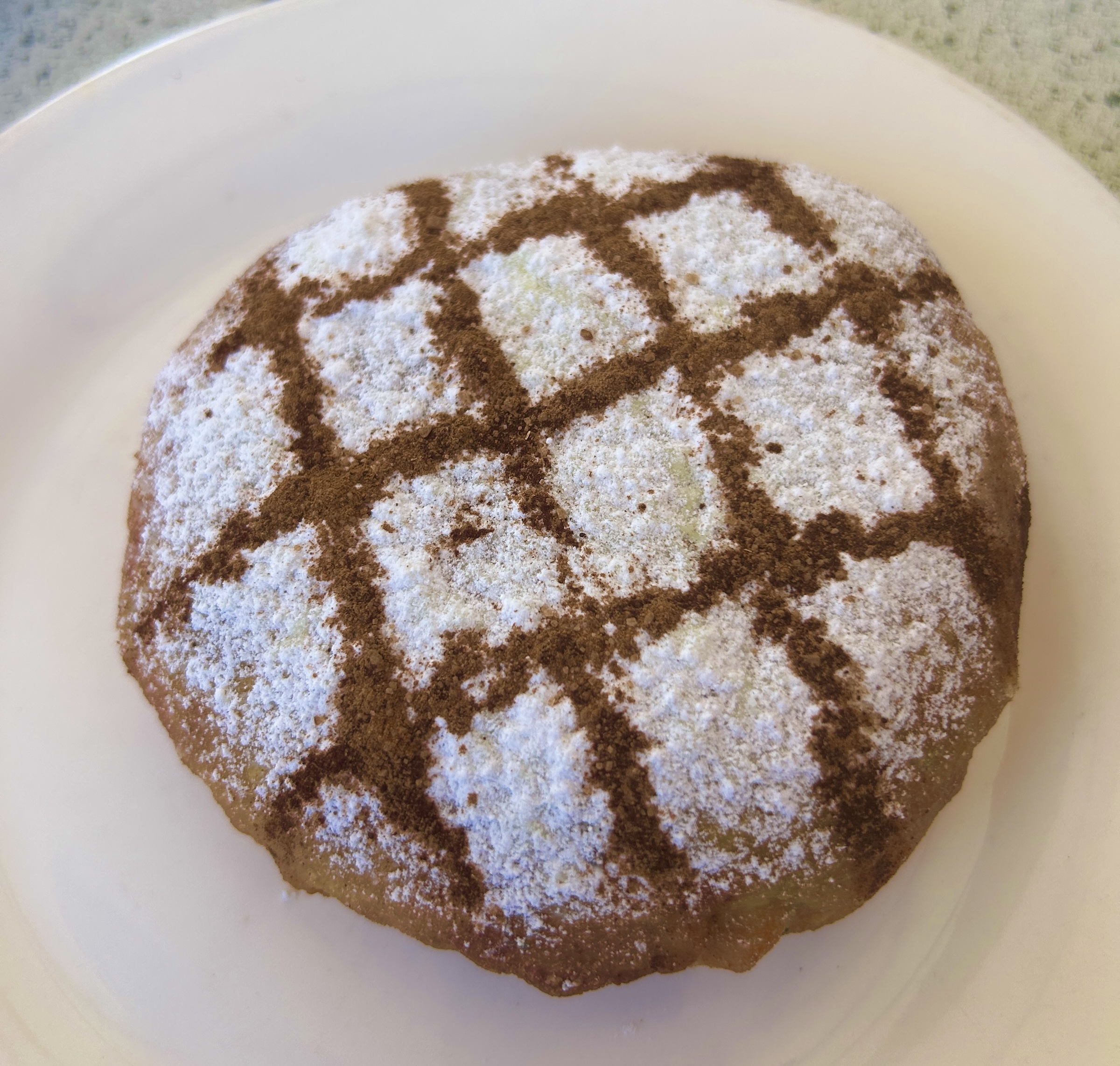
Pastillas are made from warqa, a type of dough similar to phyllo pastry, that is unique to Morocco. In one lane in the Fes medina you an see the warqa being made in the same way it has been for centuries.
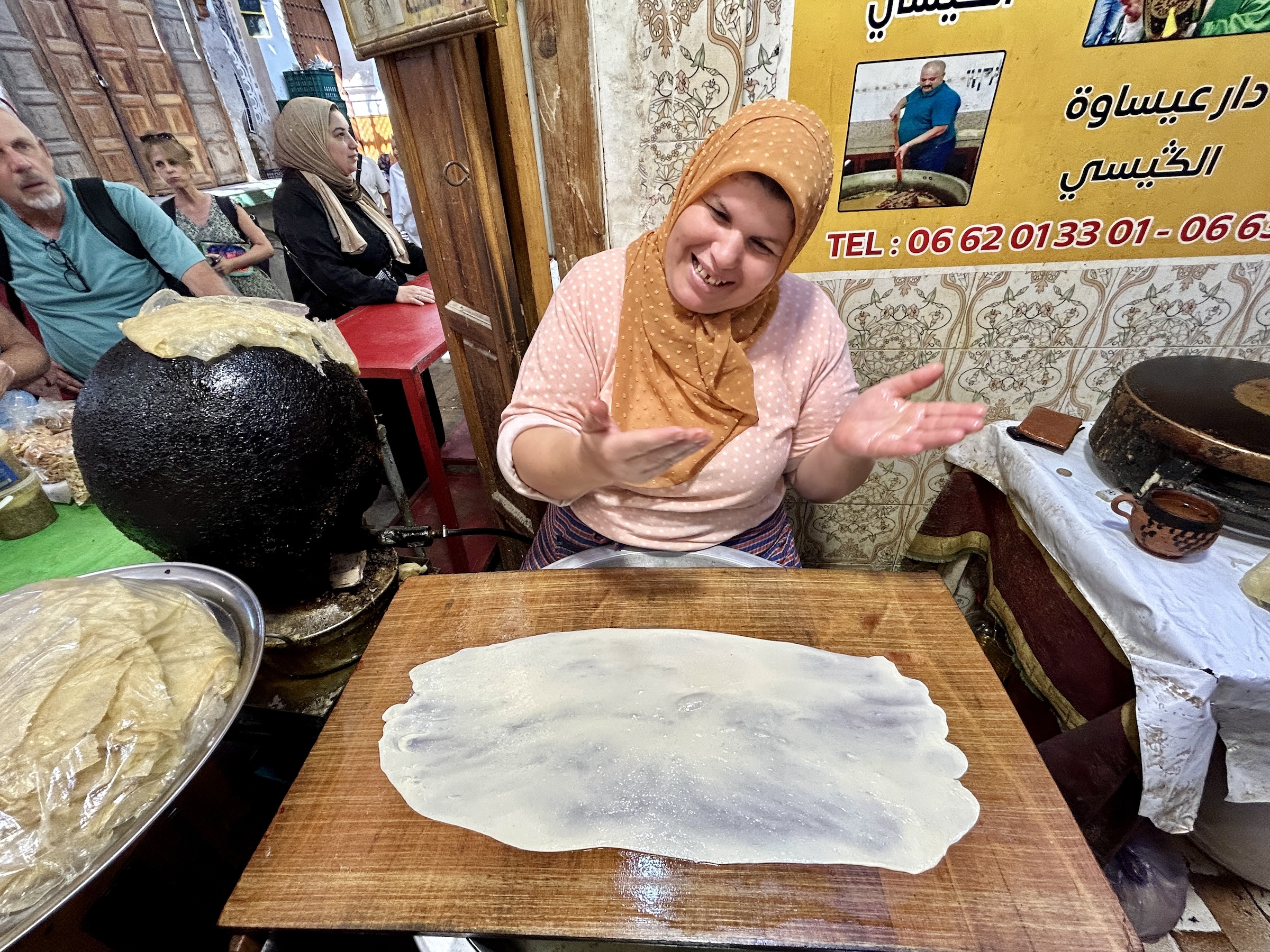
One of the welcome sights, if not for the ears, is Seffarine Square which is one of the few open air spots in the Fes medina. It is notable for the coppersmiths who have been beating out pots, pans and other wares here since the Middle Ages.
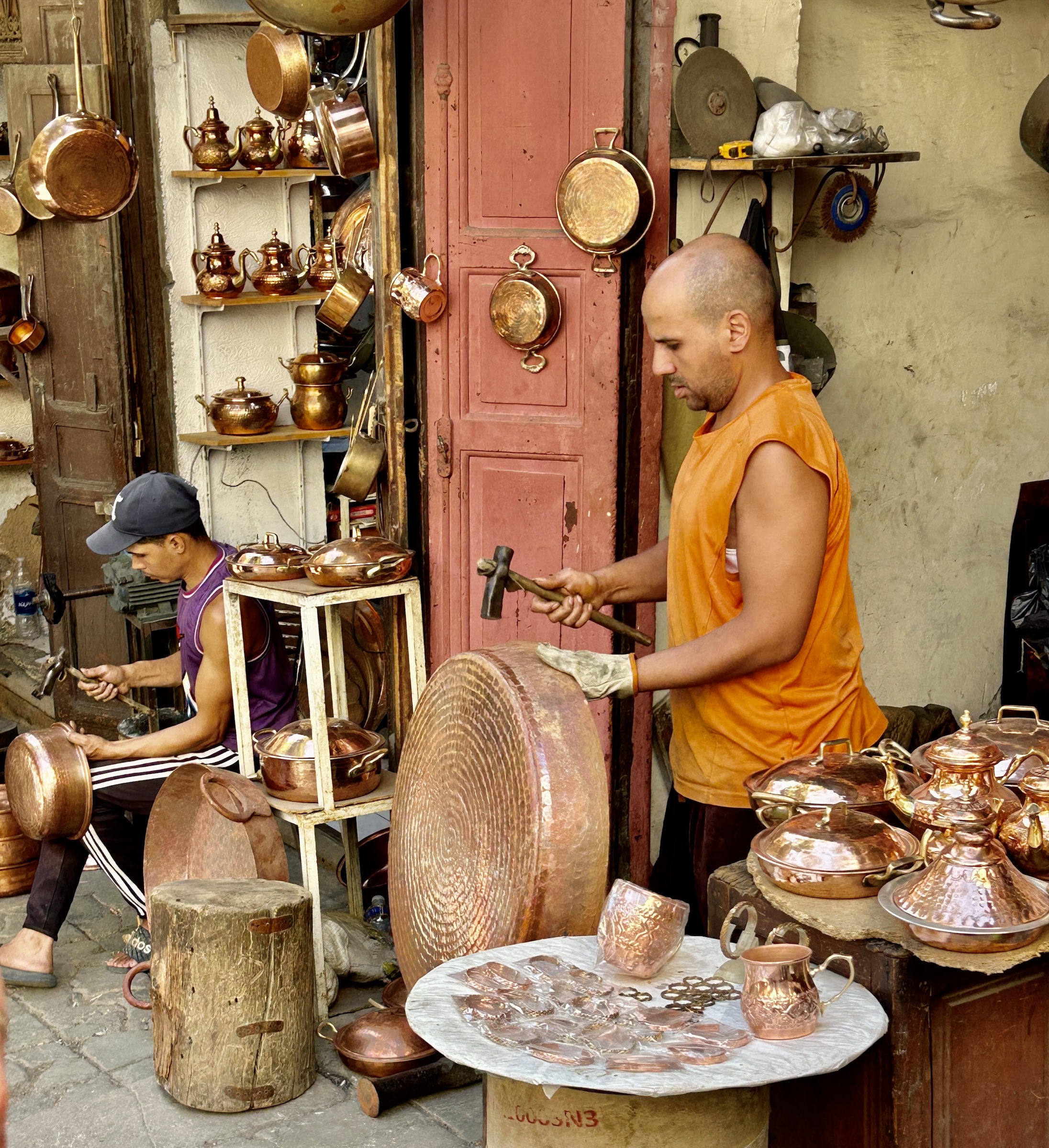
It is worth taking a few seconds to listen to the sounds of Fes medina as personified in Seffarine Square.
Sounds of Seffarine Square
Yes, a few seconds will do, thank you.
Okay, our eyes and ears have been satiated, what about our sense of smell? While there are both good aromas and some real stinkpots in the Fes medina, what we are about to experience makes the word ‘reek’ seem too mild. The Chouara tannery is one of the oldest in the world and hides are turned into leather goods the same way here that they have been since almost the foundation of the city in the 8th century. While everyone appreciates the smell of polished leather, you really have to be a masochist to want to experience how those hides get turned into leather. Our local guides warns us that the smell will be overpowering and we have the option of not climbing up a series of narrow stairs to look down at the tannery below. However, everyone is game and we are handed a piece of mint to help allay the stench to come.
Actually it’s nowhere near as bad as we were led to believe, although it is still pretty awful. This is looking down at the vats where the hides are rendered.
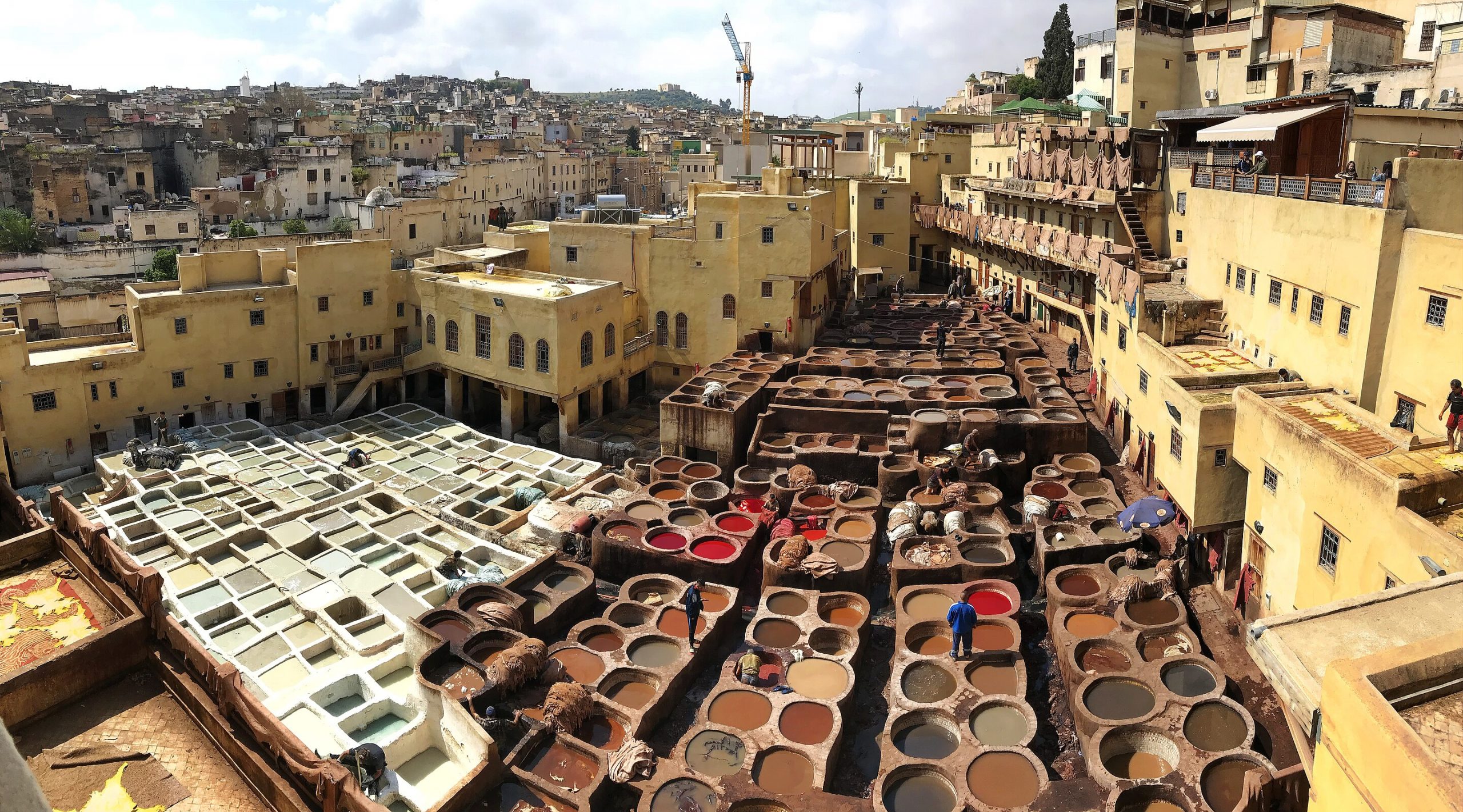
After viewing this sight for as long as our noses can take it, we descend through three floors of leather shops back to Seffarine Square and the end of our tour of the Fes medina.
I don’t really feel that my description of the place has done justice to just how unique this place is. There are lots of things to turn one off about it, but far more to make you glad that you visited this place that is unlike any other on the planet. For me it will always be one of the real highlights of the entire Morocco trip.
In the next post, on a “Now for something completely different” moment, we will say goodbye to Imperial cities and head straight for the Sahara Desert. I hope you’ll come along.

